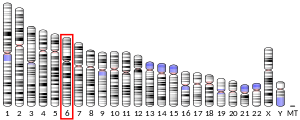UNC93A
Unc-93 homolog A (C. elegans) is a protein that in humans is encoded by the UNC93A gene.[5]
| UNC93A | |||||||||||||||||||||||||
|---|---|---|---|---|---|---|---|---|---|---|---|---|---|---|---|---|---|---|---|---|---|---|---|---|---|
| Identifiers | |||||||||||||||||||||||||
| Aliases | UNC93A, Unc-93A, dJ366N23.1, dJ366N23.2, UNC93A (gene), unc-93 homolog A (C. elegans), unc-93 homolog A | ||||||||||||||||||||||||
| External IDs | OMIM: 607995 MGI: 1933250 HomoloGene: 10356 GeneCards: UNC93A | ||||||||||||||||||||||||
| |||||||||||||||||||||||||
| |||||||||||||||||||||||||
| |||||||||||||||||||||||||
| Orthologs | |||||||||||||||||||||||||
| Species | Human | Mouse | |||||||||||||||||||||||
| Entrez | |||||||||||||||||||||||||
| Ensembl | |||||||||||||||||||||||||
| UniProt | |||||||||||||||||||||||||
| RefSeq (mRNA) | |||||||||||||||||||||||||
| RefSeq (protein) | |||||||||||||||||||||||||
| Location (UCSC) | Chr 6: 167.27 – 167.32 Mb | Chr 17: 13.11 – 13.13 Mb | |||||||||||||||||||||||
| PubMed search | [3] | [4] | |||||||||||||||||||||||
| Wikidata | |||||||||||||||||||||||||
| |||||||||||||||||||||||||
Unc93A is a major facilitator superfamily (MFS), and a putative solute carrier in humans.[6][7] It belongs to the atypical SLCs that was recently listed.[6] It is therefore presumed that UNC93A is a transporter protein.
UNC93A is closely related to UNC93B1 and MFSD11.[8][9]
UNC93A is affected by amino acid deprivation in cell cortex cultures[7][8] and starvation in in vivo samples.[8]
It is expressed in neurons, with staining close to the plasma membrane.[8]
References
- GRCh38: Ensembl release 89: ENSG00000112494 - Ensembl, May 2017
- GRCm38: Ensembl release 89: ENSMUSG00000067049 - Ensembl, May 2017
- "Human PubMed Reference:". National Center for Biotechnology Information, U.S. National Library of Medicine.
- "Mouse PubMed Reference:". National Center for Biotechnology Information, U.S. National Library of Medicine.
- "Entrez Gene: Unc-93 homolog A (C. elegans)".
- Perland E, Fredriksson R (March 2017). "Classification Systems of Secondary Active Transporters". Trends in Pharmacological Sciences. 38 (3): 305–315. doi:10.1016/j.tips.2016.11.008. PMID 27939446.
- Perland E, Bagchi S, Klaesson A, Fredriksson R (September 2017). "Characteristics of 29 novel atypical solute carriers of major facilitator superfamily type: evolutionary conservation, predicted structure and neuronal co-expression". Open Biology. 7 (9): 170142. doi:10.1098/rsob.170142. PMC 5627054. PMID 28878041.
- Ceder MM, Lekholm E, Hellsten SV, Perland E, Fredriksson R (2017). "The Neuronal and Peripheral Expressed Membrane-Bound UNC93A Respond to Nutrient Availability in Mice". Frontiers in Molecular Neuroscience. 10: 351. doi:10.3389/fnmol.2017.00351. PMC 5671512. PMID 29163028.
- Perland E, Lekholm E, Eriksson MM, Bagchi S, Arapi V, Fredriksson R (2016). "The Putative SLC Transporters Mfsd5 and Mfsd11 Are Abundantly Expressed in the Mouse Brain and Have a Potential Role in Energy Homeostasis". PLOS ONE. 11 (6): e0156912. Bibcode:2016PLoSO..1156912P. doi:10.1371/journal.pone.0156912. PMC 4896477. PMID 27272503.
- Levin JZ, Horvitz HR (April 1992). "The Caenorhabditis elegans unc-93 gene encodes a putative transmembrane protein that regulates muscle contraction". The Journal of Cell Biology. 117 (1): 143–55. doi:10.1083/jcb.117.1.143. PMC 2289394. PMID 1313436.
- de la Cruz IP, Levin JZ, Cummins C, Anderson P, Horvitz HR (October 2003). "sup-9, sup-10, and unc-93 may encode components of a two-pore K+ channel that coordinates muscle contraction in Caenorhabditis elegans". The Journal of Neuroscience. 23 (27): 9133–45. doi:10.1523/JNEUROSCI.23-27-09133.2003. PMC 6740817. PMID 14534247.
Further reading
- Liu Y, Dodds P, Emilion G, Mungall AJ, Dunham I, Beck S, Wells RS, Charnock FM, Ganesan TS (October 2002). "The human homologue of unc-93 maps to chromosome 6q27 - characterisation and analysis in sporadic epithelial ovarian cancer". BMC Genetics. 3: 20. doi:10.1186/1471-2156-3-20. PMC 134458. PMID 12381271.
This article is issued from Wikipedia. The text is licensed under Creative Commons - Attribution - Sharealike. Additional terms may apply for the media files.



